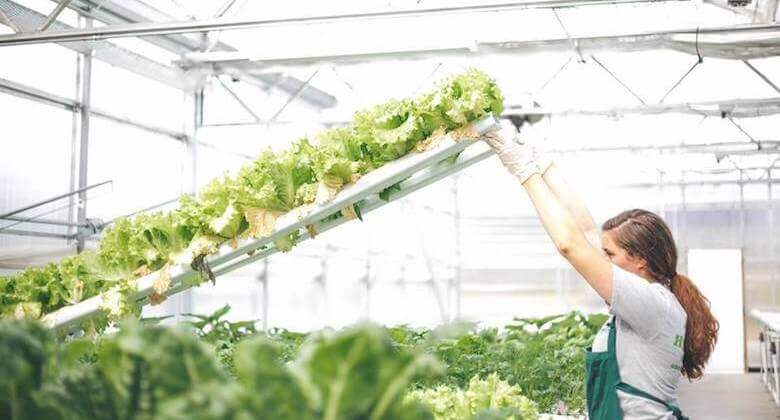
Walmart entering your home to stock your fridge with groceries, Amazon dropping Whole Foods hauls at your doorstep via drone, plant-based meat that “bleeds”—if this is increasingly how we’re eating in 2017, what can we expect in 2020? 2050? And given a growing world population and climate change concerns, which of these innovations do we actually need?
These are the big questions we’re exploring on November 3-4 at Food Loves Tech (FLT): our all you can eat and drink Industry City expo where you can test drive food technologies from field and sea to next gen frontiers. We’ll also have expert panels answering some of the most important questions facing our food supply including one entitled “Can Indoor Agriculture Help Us Produce More Food, More Sustainably?”
Joe Swartz has a bit of a reputation in the hydroponic industry. He comes from a traditional farming background and now uses this expertise to provide hydroponic growers with practical, usable advice as vice president of commercial sales and technical support at American Hydroponics (AmHydro). We talked to Joe about the growth of controlled environment agriculture and the importance of finding the appropriate combination of technologies to fit any given situation.
Edible Brooklyn: How did you get started in hydroponic growing?
Joe Swartz: I’m a fourth generation farmer. In the early 1980s, my dad was a mixed potato and vegetable farmer in western Massachusetts, and I was looking at farming as a profession. The farming economy was very poor at that time and I was forced to look long and hard at some form of season extension or year-round production that I could do on a small scale. I found hydroponics. There wasn’t a lot of information available then, but I was fortunate enough to meet a retired professor at Cornell who had pioneered some of the early work in hydroponics. I became a full-time, year-round hydroponic vegetable grower in traditional agricultural area. I was considered kind of a kook.
EB: How did you transition from full-time farming to providing support to other growers at AmHydro?JS: I had seen that as the industry was starting to grow, there was a lot of misinformation. There were companies selling supplies and academics giving advice to growers but there was very little practical advice and very few experienced growers. I started working as a consultant, sharing information and advice with growers from my experience. I joined AmHydro a couple of years ago because I am a big fan of the company’s approach, which is focused on working with growers to make them successful. I’ve helped to expand their reach beyond just large-scale commercial growing systems to provide a soup-to-nuts range of services at different scales. We’re working with small-scale growers who are setting up a 1000 square foot operation up to 20 acres under glass.

EB: There has been a growth in interest in controlled environment agriculture in recent years. What is bringing people to hydroponics?
JS: Hydroponics gives us the ability to produce food in an area that is completely unsuitable for farming, whether it’s geography or infrastructure or lack of fertile soil. In the past 30+ years that I’ve been in the business, there has been a steady, organic growth of the industry. One factor is the demand by the consumer for local production, which is a complete paradigm shift from when I started 20 years ago. The other factor is the environmental impacts of traditional agricultural production—the large amount of water and land it requires. Hydroponics will use 90% less water than traditional field systems.
EB: You came from a traditional farming background and I’m curious how common that is. Who is adopting hydroponic technologies?
JS: A lot of people are from the traditional agriculture sector. But two or three times we’ve also seen these bubbles where there is a lot of public interest and outside investment in the industry. We saw that in the 1980s when all these huge multinational corporations like General Electric built large hydroponic greenhouses and they were going to solve all the world’s food issues. Within a few short years, all of these projects failed on a large scale. It was because they came at it with no growing experience, looking to the technology to do all the work. The farming and business was an afterthought.
We are seeing a similar bubble right now with indoor vertical farming. On the one hand, it’s really great to see so many young people wanting to be involved in farming. But it shows one of these shifts with too much focus on technologies.
EB: The panel you’re participating in at Food Loves Tech asks “can indoor agriculture help us produce more food, more sustainably?” Can you talk more about the role that you see for that technology?
JS: It’s kind of like the shiny object that a lot of people are focusing on right now. You can set up these indoor growing systems that grow high volumes of food in any climate. And a lot of people believe suddenly all of the environmental and food distribution and food security issues will be taken care of by this technology. And it’s not a knock on vertical farming. Some of these technologies have applications for sure, but there’s no such thing as one size fits all.
Traditional agriculture has always been fast paced. This is a very dynamic business with a lot of moving parts. Technologies are tools, and not all tools are appropriate in all situations. Whether it is hydroponics or vertical farming or indoor farming or shipping containers, there is no one application that actually works. We need to select and apply the right technologies and combinations of technologies to achieve economic and environmental sustainability.



